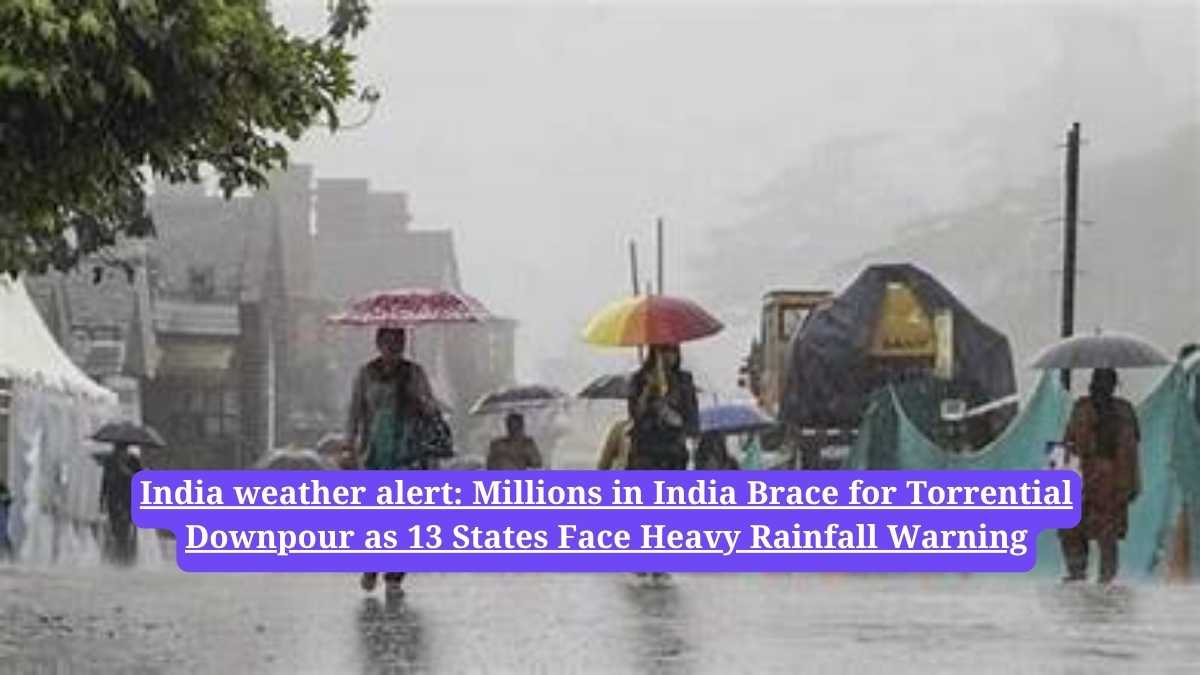Join WhatsApp
Join NowIndia weather alert: Millions of citizens across India are on high alert after the nation’s top weather agency issued a significant and widespread heavy rainfall warning. The India Meteorological Department (IMD), in its latest bulletin, has sounded the alarm for Wednesday, October 1st, forecasting a powerful wave of torrential rain set to lash 13 states, potentially disrupting daily life and posing a risk of flooding.
This major weather event marks a potent surge in monsoon activity, putting authorities, disaster management teams, and the public on notice to prepare for severe conditions. The warning spans the length and breadth of the country, from the lush hills of the Northeast to the bustling coastal regions of the West, signaling a large-scale and impactful weather pattern.
Which States are on High Alert?
The IMD’s official warning identifies a vast and diverse area under threat. Residents in the following states are urged to exercise extreme caution and stay updated with local advisories:
-
Northeastern India: Arunachal Pradesh, Assam, Meghalaya, Nagaland, Manipur, Mizoram, and Tripura. This region, already known for its heavy rainfall, is expected to receive an intensified deluge.
-
Central & Eastern India: Chhattisgarh and Odisha are bracing for significant downpours, which could impact agriculture and river levels.
-
Western India: Goa, Maharashtra, and Gujarat. The coastal states, including major metropolitan areas, could face severe waterlogging and flash floods.
-
Southern India: Andhra Pradesh is also included in the warning, with its coastal areas particularly vulnerable to the intense weather spell.
What Does a “Heavy Rainfall” Warning Mean?
For those unfamiliar with meteorological terms in India, the IMD’s “heavy rainfall” alert is a serious advisory. This isn’t just a forecast for a passing shower; it signifies a concentrated downpour that can lead to a range of hazardous situations, including:
-
Flash Floods: Rapid and extreme flooding in low-lying areas.
-
Severe Waterlogging: Clogging of city drainage systems, bringing urban transport to a standstill.
-
Landslide Risks: Particularly in the hilly regions of the Northeast and the Western Ghats (affecting Goa and Maharashtra).
-
Disruption to Transport: Flights, trains, and road traffic are often severely impacted by such weather events.
This level of rainfall can quickly overwhelm infrastructure, and citizens are advised to prepare for potential power outages and to avoid vulnerable structures.
Why is This Happening? A Glimpse into the Monsoon’s Final Act
This intense weather phenomenon is largely driven by the complex dynamics of the monsoon’s withdrawal phase. As the seasonal monsoon begins its retreat from the Indian subcontinent, it often unleashes final, powerful bursts of moisture-laden winds. The current system appears to be a result of a combination of atmospheric pressures and high moisture content, creating the perfect conditions for a widespread and severe rainfall event across these 13 states.
Urgent Safety Advisory for Residents and Travelers
Given the scale of the IMD warning, it is crucial to prioritize safety. If you are in one of the affected states:
-
Stay Informed: Continuously monitor official updates from the IMD and local disaster management authorities.
-
Avoid Unnecessary Travel: Driving through waterlogged streets is extremely dangerous and can damage your vehicle or leave you stranded.
-
Prepare an Emergency Kit: Keep essentials like a flashlight, first-aid supplies, clean drinking water, and non-perishable food ready.
-
Secure Your Home: Check for drainage blockages and secure loose items outside your house that could be affected by strong winds or rain.
-
Be Cautious of Waterborne Diseases: Avoid contact with floodwater as much as possible.
This powerful weather system serves as a stark reminder of nature’s force. Preparedness and caution are the best defense against the impending downpour.


















